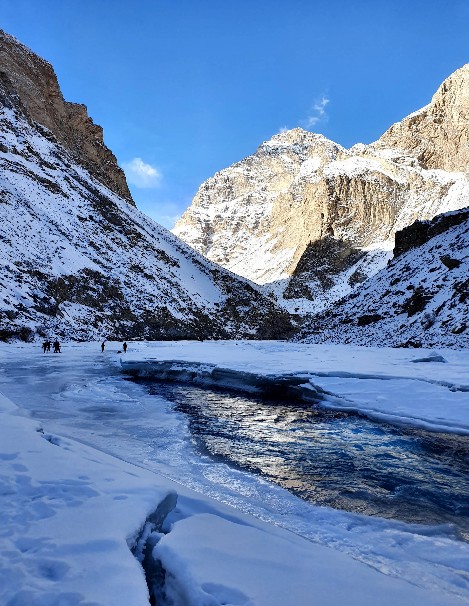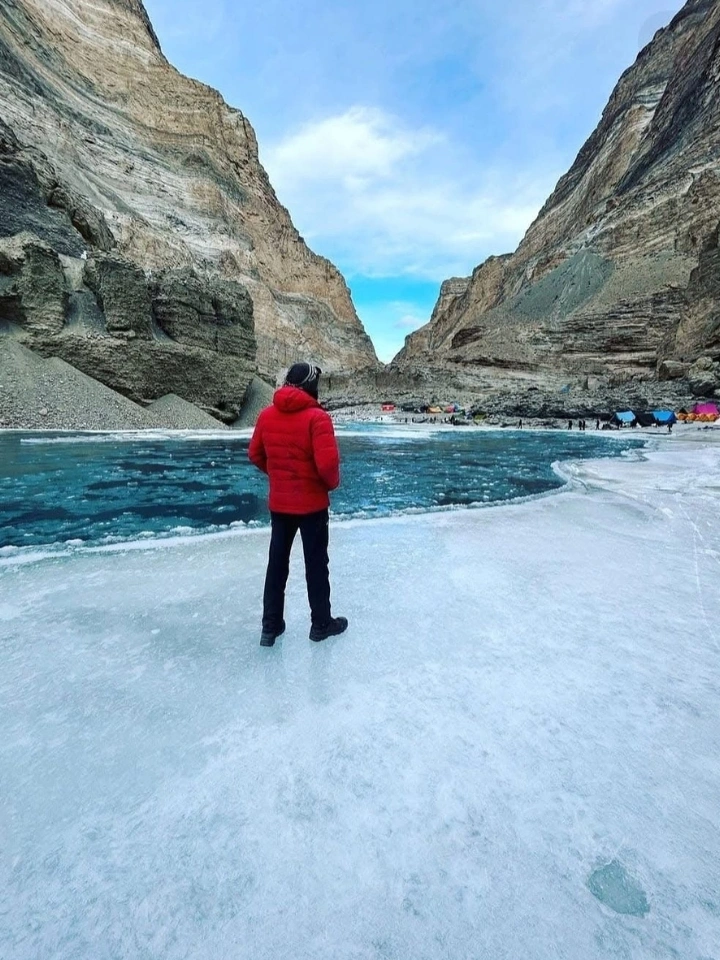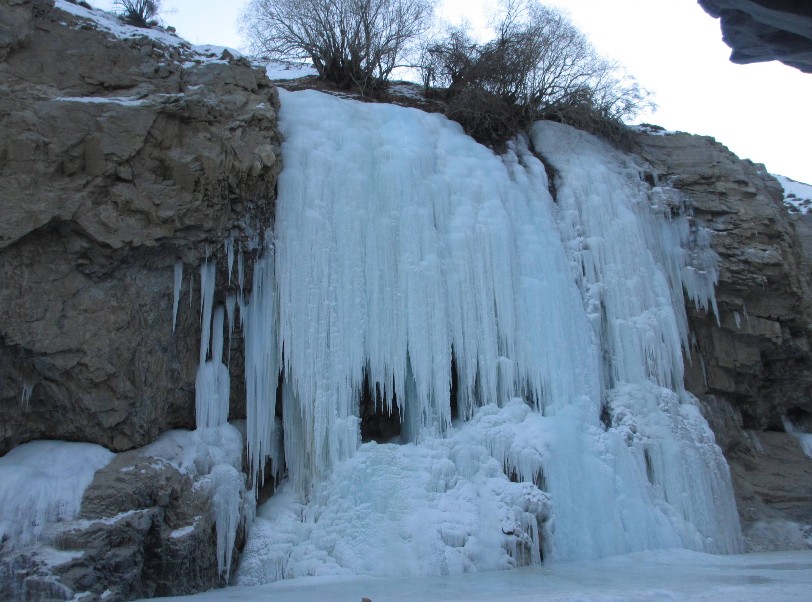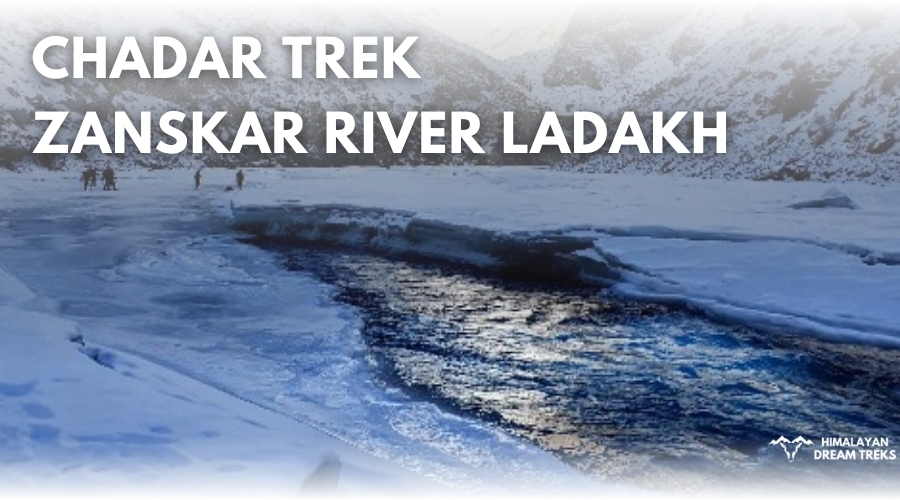The Chadar Trek also called the Frozen River Trek or the Zanskar Gorge Trek is one of the most attractive treks in India. It takes place in Ladakh where the Zanskar River freezes over in winter and forms a sheet of ice known locally as the “chadar” or blanket. Walking on this frozen surface with icy cliffs rising high on both sides feels almost unreal.
Unlike other treks where you climb mountains or cross meadows, here you are literally walking on a river. Cold water flows just a few inches below your feet and every step needs balance and awareness. It is as thrilling as it sounds and also one of the toughest treks in the India.
Where is the Chadar Trek Located?
The Chadar Trek is located in the Union Territory of Ladakh in northern India. The trek route follows the frozen Zanskar River which is a tributary of the Indus. This gorge is narrow in many places with steep cliffs up to 600 meters high and sections where the river is just five meters wide.

The trek begins from a point near Chilling about 65 kilometers from Leh and moves along camps like Tilad Sumdo, Tsomo Paldar, Tibb Cave, and Nerak. The Nerak Waterfall which freezes completely in winter is one of the highlights and the turning point for most trekkers.
Trek Itinerary
- Day 1: Reach Leh and settle into your hotel for an overnight stay.
- Day 2: Spend the day in Leh, giving your body time to adjust to the high altitude.
- Day 3: Undergo the mandatory health check and complete the required permit formalities.
- Day 4: Drive from Leh to Shingra Yokma, then begin the trek leading to the campsite at Sumo.
- Day 5: Continue the journey on foot from Sumo to Tibb, surrounded by dramatic landscapes.
- Day 6: Trek ahead to Nerak and witness the iconic frozen waterfall, a highlight of the trek.
- Day 7: Retrace your steps from Nerak and make your way back to Tibb.
- Day 8: Trek back from Tibb to Shingra Yokma and return to Leh by road.
- Day 9: Depart from Leh, marking the end of your adventure.
What is the Height and Distance of the Chadar Trek?
The altitude of the Chadar Trek is around 3,398 meters (11,150 feet) above sea level. The full trek covers a distance of about 105 kilometers (65 miles). On average trekkers walk 15 to 16 kilometers per day and the standard itinerary usually takes 8 to 9 days to complete.
There are extended versions of the trek that go further toward Lingshed or even to Padum which can take up to two weeks. However the most popular and doable version for most people is the route up to Nerak and back.

Best Time for the Chadar Trek
The Chadar Trek is a winter-only trek. The frozen river forms properly only between mid-January and mid-February. That is the short window when the trek is possible. This is also the time when temperatures in Ladakh drop drastically going as low as -30 to -35°C at night.
Trekkers often ask if Chadar Trek can be done in March or summer. The answer is no. By March the ice starts melting and in summer the Zanskar River flows freely with strong currents making the trek impossible.
Temperature and Conditions During the Trek
The most challenging part of the trek is not the walking but the weather. Daytime temperatures range between -10°C and -15°C while nights can fall to -30°C or even lower. Even a small rise or drop in temperature changes the condition of the ice making it fragile or slippery.
The ice is not always a smooth sheet. It forms, cracks, and melts depending on the weather. Sometimes trekkers find themselves walking on slippery glass-like surfaces. Sometimes on broken ice where water flows in between. At times the ice is uneven and hidden slabs can make the path unstable. Walking carefully and patiently is key.
Must Read: Mountain Word or Terminology Used in Outdoor
Why is the Chadar Trek Difficult?
The Chadar Trek is considered tough for several reasons. The extreme cold, long walking distances, and uncertain terrain make it a test of both mental and physical endurance.
- Walking on ice: It is not the same as walking on normal ground. Balance is required and slipping is common.
- Cold temperatures: The risk of frostbite and hypothermia is real. Trekkers must know how to keep themselves warm.
- Limited facilities: Campsites are basic, often just tents set up near caves or flat spots. The Tibb Cave for example is one such natural shelter used by trekkers.
- Remote environment: Once you are on the trek there is no easy way out. Medical help is limited and even small issues can become serious in the cold.
This is why the trek is not recommended for beginners who have never experienced high-altitude trekking or extreme cold. At the same time with the right preparation, determination, and guidance many people including first-timers have successfully completed it.
Must Read: How to Overcome Extreme Cold During the Trek
Cultural and Natural Highlights
Even with the challenges the trek offers sights and experiences that are unmatched.
- The Frozen Waterfall at Nerak: This is one of the most photographed spots on the trek. The entire waterfall freezes into a massive wall of ice sparkling in shades of blue and white.
- Tibb Cave: A historic resting point where trekkers camp inside a naturally formed overhang, sheltered from the winds.
- Zanskari culture: Traditionally the frozen river was the only way for locals to travel between villages and to Leh in winter. Walking on this path gives a glimpse into their way of life.
- Untouched beauty: The gorge, the silence, the white landscapes, and the occasional sound of water flowing under the ice create an atmosphere found nowhere else.

How to Reach the Chadar Trek Base Camp
All treks to Chadar begin from Leh which is well connected by air. From cities like Delhi there are daily flights to Leh airport. Once in Leh trekkers spend a couple of days acclimatizing to the altitude before heading toward the starting point at Tilad Sumdo or Shingra Koma.
Those asking how to reach the Chadar Trek from Bangalore or other distant cities can fly to Delhi first and then connect to Leh.
What to Carry for the Chadar Trek
Packing right is one of the most important steps. Essentials include:
- High-quality down jacket and multiple warm layers
- Waterproof trekking boots with good grip
- Sleeping bag rated for -20°C or lower
- Trekking poles for balance on the ice
- Sunglasses, gloves, woolen socks, thermal wear
- Basic medicines, toiletries, and a headlamp
- Camera gear if you want but protecting batteries from the cold is crucial
Many trekkers ask how to pack your bag for Chadar or how to use DSLR cameras in such conditions. The main thing to remember is to keep gear compact, waterproof, and protected from extreme cold. Batteries should be kept close to the body when not in use.
Safety and Preparation
Trekkers often wonder if Chadar Trek is safe. The answer is that it can be safe if done with preparation and caution. Guided groups, permits, and rescue measures are in place but nature is always unpredictable here.
Fitness needed: You do not need to be a professional mountaineer but you must be fit enough to walk 10 to 15 kilometers daily with a backpack. Cardio exercises, running, and strength training for legs and core should be part of your preparation at least 2 to 3 months before the trek.
Experience: Some prior trekking experience is recommended though many fit beginners also attempt Chadar successfully under good guidance.
Risks: Hypothermia, frostbite, slips on ice, and altitude-related issues are the main risks. Listening to guides, following instructions, and moving carefully reduce these dangers.
Must Read: Winter Trekking Tips to Be like a Pro
Final Thoughts: Chadar Trek, a Dream for Every Trekker
The Chadar Trek combines everything that makes an adventure memorable. It has danger, beauty, remoteness, and culture all in one. It pushes you to your limits but also rewards you with experiences that stay with you for life.
Walking on a frozen river, hearing the ice crack beneath your boots, seeing the frozen Nerak waterfall, and sharing stories with locals around a campfire in -25°C are things that cannot be found anywhere else.
That is why for many trekkers across the world the Chadar Trek is not just another trek. It is a dream.
Must Read: Best Winter Treks in India for Beginners
FAQs
What is the Chadar Trek famous for?
It is famous for being a frozen river trek, something very rare in the world. The frozen Nerak Waterfall is another highlight.
How long is the Chadar Trek?
About 105 kilometers (65 miles) in total, usually covered in 8 to 9 days.
Is the Chadar Trek banned or closed?
With road construction between Nimmu and Padum the traditional need for this trek may be reduced. There are also concerns about the impact on local wildlife like snow leopards. For now the trek is still open during winters but its future is uncertain.
Is Chadar Trek worth it?
For anyone seeking adventure, cultural experience, and raw natural beauty yes it is worth every step.
Can a beginner go to Chadar Trek?
Yes, beginners can do the Chadar Trek, but only with strong physical and mental preparation and by joining a reliable group. The extreme cold, icy terrain, and challenging climbs make it tough even for first-timers.


Leave a Comment